7-ROUTING IN COMPUTER NETWORKS .pptx
- 2. Basic Routing Concepts ’üĮ What is routing? ŌŚ” The term routing refers to taking a packet from one device and sending it through the network to another device on a different network. ’üĮ List of the minimum factors a router must know to be able to affectively route packets: ŌŚ” Destination address ŌŚ” Neighbor routers from which it can learn about remote networks ŌŚ” Possible routes to all remote networks ŌŚ” The best route to each remote network ŌŚ” How to maintain and verify routing information
- 3. Routing types ’üĮ There are several ways to configure the routing tables to include all the networks in your internetwork so that packets will be properly forwarded. Understanding the different types of routing will be really helpful when choosing the best solution for your specific environment and business requirements. ’üĮ Static routing ’üĮ Default routing ’üĮ Dynamic routing
- 4. Static Routing ’üĮ Static routing is the process that ensures when you manually add routes in each routerŌĆÖs routing table. Predictably, there are pros and cons to static routing, but thatŌĆÖs true for all routing approaches. ŌŚ” There is no overhead on the router CPU, which means you could probably make do with a cheaper router than you would need for dynamic routing. ŌŚ” There is no bandwidth usage between routers, saving you money on WAN links as well as minimizing overhead on the router since youŌĆÖre not using a routing protocol. ŌŚ” It adds security because you, the administrator, can be very exclusive and choose to allow routing access to certain networks only.
- 5. Static Routing And here are the cons: ŌŚ” Whoever the administrator is must have a vault-tight knowledge of the internetwork and how each router is connected in order to configure routes correctly. If you donŌĆÖt have a good, accurate map of your internetwork, things will get very messy quickly! ŌŚ” If you add a network to the internetwork, you have to tediously add a route to it on all routers by hand, which only gets increasingly insane as the network grows. ŌŚ” Due to the last point, itŌĆÖs just not feasible to use it in most large networks because maintaining it would be a full-time job in and of itself.
- 6. Static Routing ’üĮ HereŌĆÖs the command syntax you use to add a static route to a routing table from global config: ’üĮ ip route [ destination_network ] [ mask ] [ next-hop_address or exitinterface ] [ administrative_distance ] [permanent] ’üĮ This list describes each command in the string: ŌŚ” ip route The command used to create the static route. ŌŚ” destination_network The network youŌĆÖre placing in the routing table. ŌŚ” mask The subnet mask being used on the network. ŌŚ” next-hop_address This is the IP address of the next-hop router that will receive packets and forward them to the remote network, which must signify a router interface thatŌĆÖs on a directly connected network. You must be able to successfully ping the router interface before you can add the route. Important note to self is that if you type in the wrong next-hop address or the interface to the correct router is down, the static route will show up in the routerŌĆÖs configuration but not in the routing table.
- 7. Static Routing ’üĮ HereŌĆÖs the command syntax you use to add a static route to a routing table from global config: ’üĮ ip route [ destination_network ] [ mask ] [ next-hop_address or exitinterface ] [ administrative_distance ] [permanent] ’üĮ This list describes each command in the string: ŌŚ” exitinterface Used in place of the next-hop address if you want and shows up as a directly connected route. ŌŚ” administrative_distance By default, static routes have an administrative distance of 1 or 0 if you use an exit interface instead of a next-hop address. You can change the default value by adding an administrative weight at the end of the command. ŌŚ” permanent If the interface is shut down or the router canŌĆÖt communicate to the next-hop router, the route will automatically be discarded from the routing table by default. Choosing the permanent option keeps the entry in the routing table no matter what happens.
- 8. Default Routing ’üĮ A stub network indicates that the networks in this design have only one way out to reach all other networks, which means that instead of creating multiple static routes, we can just use a single default route. This default route is used by IP to forward any packet with a destination not found in the routing table, which is why it is also called a gateway of last resort. ’üĮ ip route 0.0.0.0 0.0.0.0 s0/0 ’üĮ Configuring a default route is a lot easier than typing a bunch of static routes! Everything the router receives with a destination not found in the routing table will be forwarded to 172.16.10.5. ’üĮ You need to be careful where you place default routes because you can easily create a network loop!
- 9. Dynamic Routing ’üĮ With dynamic routing, protocols are used to find networks and update routing tables on routers. This is a whole lot easier than using static or default routing, but it will cost you in terms of router CPU processing and bandwidth on network links. ’üĮ A routing protocol defines the set of rules used by a router when it communicates routing information between neighboring routers. Common routing protocols include RIP, EIGRP, and OSPF.
- 10. Types of Routing Protocols ’üĮ There are two basic types of routing protocols: ’üĮ Distance-vector protocols ’üĮ Link-state protocols
- 11. Distance Vector ’üĮ The distance-vector protocols in use today find the best path to a remote network by judging distance. ’üĮ In RIP routing, each instance where a packet goes through a router is called a hop, and the route with the least number of hops to the network will be chosen as the best one. The vector indicates the direction to the remote network. ’üĮ RIP is a distance-vector routing protocol and periodically sends out the entire routing table to directly connected neighbors.
- 12. (a) A network. (b) Input from A, I, H, K, and the new routing table for J. Distance Vector Routing
- 13. Distance Vector ’üĮ Concerns: ŌŚ” Low speed links ŌŚ” Slow Convergence ŌŚ” Count to infinity ’üĮ The simplicity and maturity of distance vector protocols has led to their popularity. The primary drawback of traditional implementation of distance vector protocols is slow convergence
- 14. The Count-to-Infinity Problem The count-to-infinity problem
- 15. Link State ’üĮ In link-state protocols, also called shortest-path-first protocols, the routers each create three separate tables. ŌŚ” One of these tables keeps track of directly attached neighbors, ŌŚ” One determines the topology of the entire internetwork ŌŚ” And one is used as the routing table. ’üĮ Routers running link-state protocols do not exchange routing tables as distance vector protocols do. Rather, they exchange information about adjacent neighbors and networks and include metric information associated with the connection.
- 16. Administrative Distance ’üĮ The administrative distance (AD) is used to rate the trustworthiness of routing information received on a router from a neighbor router. ’üĮ An administrative distance is represented by an integer from 0 to 255, where 0 is the most trusted and 255 means no traffic will be passed via this route. ’üĮ If a router receives two updates listing the same remote network, the first thing the router checks is the AD. If one of the advertised routes has a lower AD than the other, then the route with the lowest AD will be chosen and placed in the routing table. ’üĮ If both advertised routes to the same network have the same AD, then routing protocol metrics like hop count and/or bandwidth of the lines will be used to find the best path to the remote network. The advertised route with the lowest metric will be placed in the routing table. ’üĮ But if both advertised routes have the same AD as well as the same metrics, then the routing protocol will load-balance to the remote network, meaning the protocol will send data down each link.
- 17. Administrative Distance ’üĮ Table shows the default administrative distances that a Cisco router uses to decide which route to take to a remote network.
- 18. Split Horizon ’üĮ Split horizon is a type of distance-vector routing rule used to prevent routing loops in distant-vector routing protocols. When a router learns a route update from a neighbor, the router will not advertise the update back out the interface on which it was received.
- 19. Metric ’üĮ Often referred to as routing metric, a metric is a measurement used by a routing protocol to calculate the best path to a remote network. Each routing protocol uses a different metric to calculate the best path.
- 20. Next Hop ’üĮ Next hop refers to the next closest router a packet will go through on its way to its destination.
- 21. Thanks 21
Editor's Notes
- #2: The term routing refers to taking a packet from one device and sending it through the network to another device on a different network. Routers donŌĆÖt really care about hostsŌĆö they only care about networks and the best path to each one of them. The logical network address of the destination host is key to get packets through a routed network.
- #3: if a network isnŌĆÖt directly connected to the router, the router must use one of two ways to learn how to get to the remote network. The static routing method requires someone to hand-type all network locations into the routing table, which can be a pretty daunting task when used on all but the smallest of networks! Conversely, when dynamic routing is used, a protocol on one router communicates with the same protocol running on neighboring routers. The routers then update each other about all the networks they know about and place this information into the routing table. If a change occurs in the network, the dynamic routing protocols automatically inform all routers about the event. If static routing is used, the administrator is responsible for updating all changes by hand onto all routers.
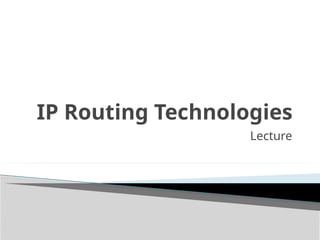
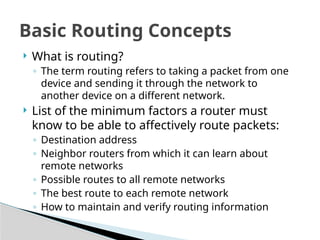
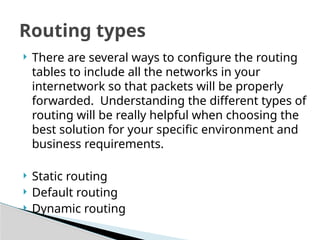
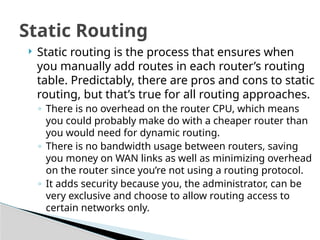

![Static Routing
’üĮ HereŌĆÖs the command syntax you use to add a static route to
a routing table from global config:
’üĮ ip route [ destination_network ] [ mask ] [ next-hop_address or
exitinterface ] [ administrative_distance ] [permanent]
’üĮ This list describes each command in the string:
ŌŚ” ip route The command used to create the static route.
ŌŚ” destination_network The network youŌĆÖre placing in the routing
table.
ŌŚ” mask The subnet mask being used on the network.
ŌŚ” next-hop_address This is the IP address of the next-hop router that
will receive packets and forward them to the remote network, which
must signify a router interface thatŌĆÖs on a directly connected
network. You must be able to successfully ping the router interface
before you can add the route. Important note to self is that if you
type in the wrong next-hop address or the interface to the correct
router is down, the static route will show up in the routerŌĆÖs
configuration but not in the routing table.](https://image.slidesharecdn.com/7-routing-250126091730-d5291289/85/7-ROUTING-IN-COMPUTER-NETWORKS-pptx-6-320.jpg)
![Static Routing
’üĮ HereŌĆÖs the command syntax you use to add a static route
to a routing table from global config:
’üĮ ip route [ destination_network ] [ mask ] [ next-hop_address
or exitinterface ] [ administrative_distance ] [permanent]
’üĮ This list describes each command in the string:
ŌŚ” exitinterface Used in place of the next-hop address if you want
and shows up as a directly connected route.
ŌŚ” administrative_distance By default, static routes have an
administrative distance of 1 or 0 if you use an exit interface
instead of a next-hop address. You can change the default value
by adding an administrative weight at the end of the command.
ŌŚ” permanent If the interface is shut down or the router canŌĆÖt
communicate to the next-hop router, the route will automatically
be discarded from the routing table by default. Choosing the
permanent option keeps the entry in the routing table no matter
what happens.](https://image.slidesharecdn.com/7-routing-250126091730-d5291289/85/7-ROUTING-IN-COMPUTER-NETWORKS-pptx-7-320.jpg)

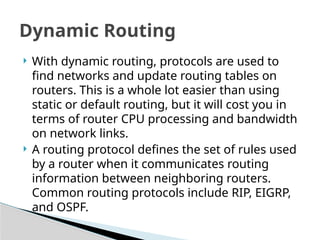






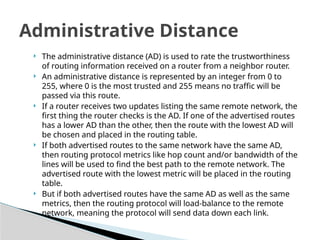
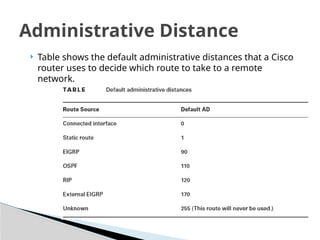





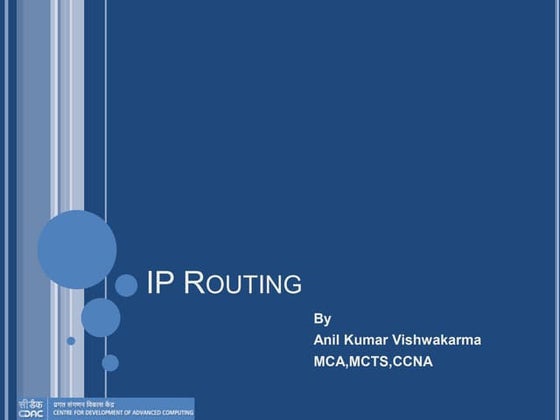
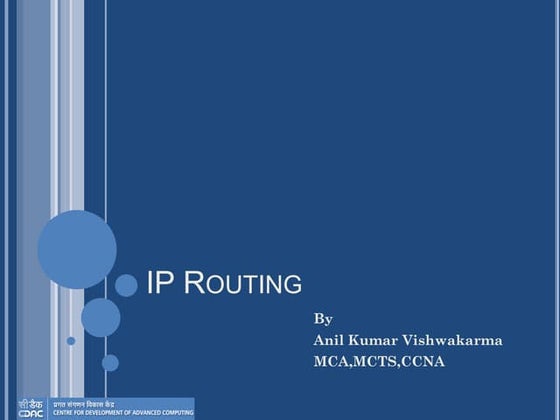












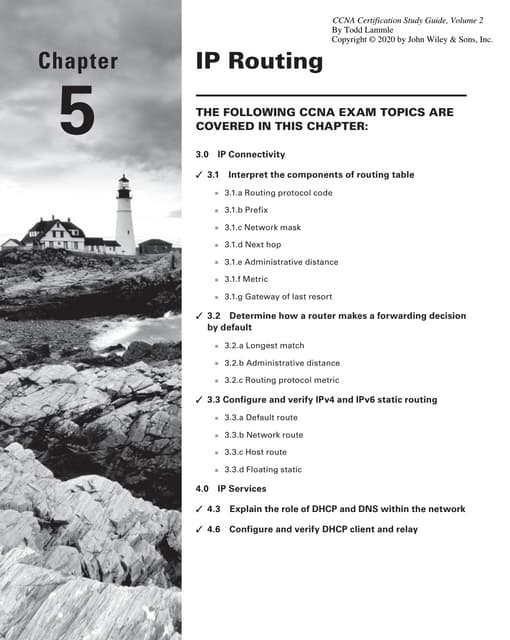





































![[HIFLUX] Lok Fitting&Valve Catalog 2025 (Eng)](https://cdn.slidesharecdn.com/ss_thumbnails/lokfittingen-250528072439-8696f1c6-thumbnail.jpg?width=560&fit=bounds)